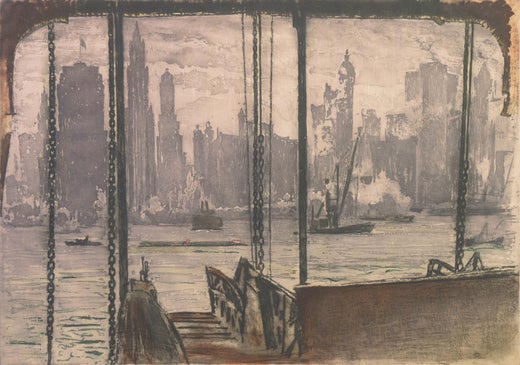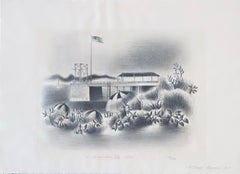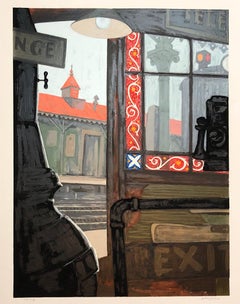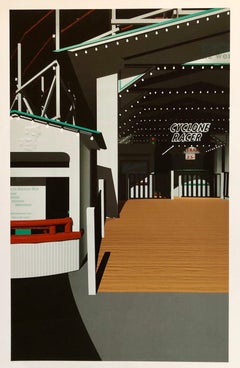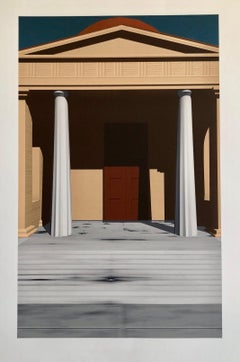Want more images or videos?
Request additional images or videos from the seller
1 of 6
Max PollakLower East Side Tenements Yiddish Barber Shop 1920's Aquatint Etching Judaica1929
1929
Price:$1,200
About the Item
- Creator:Max Pollak (1886 - 1970, Austrian)
- Creation Year:1929
- Dimensions:Height: 15 in (38.1 cm)Width: 9.5 in (24.13 cm)
- Medium:
- Movement & Style:
- Period:
- Condition:mat has wear. 8 7/8 x 4 3/4" platemark. mat measures 15 x 9.5.
- Gallery Location:Surfside, FL
- Reference Number:1stDibs: LU38213716882
Max Pollak
Max Pollak, painter and printmaker, was born in Prague, Czechoslovakia on February 2, 1886, but his family moved to Vienna, Austria when he was six months old. He was raised in Vienna and, in 1902, at sixteen years of age he entered the Vienna Academy of Art. He studied painting and printmaking under William Unger and Ferdinand Schmutzer. In 1912, he traveled to Italy, France, and Holland to study and paint. During the First World War, he was appointed painter of the Austrian Army. He immigrated to the U.S. in 1927, living for a time on the East Coast where he traveled about and produced an amazing series of color aquatints of New York, Cincinnati, and Detroit. His first exhibition at the 57th Street Art Gallery in New York was a commercial success and he was commissioned by Theodore Dreiser in 1929 to illustrate his book, My City, and eight of Pollak's color aquatints are reproduced in the book. In 1938, Pollak and his wife, Friedl, moved to San Francisco, California. Pollak was inspired by his new city and its environs and produced beautiful views of San Francisco, the Golden Gate Bridge, and Sausalito. Later travels were to Mexico and Guatemala. Pollak was equally facile working in drypoint, aquatint, and soft ground etching. One of his specialties was portraiture and he produced a number of drypoints of noteworthy people and dancers. Some of his color aquatints of San Francisco and Sausalito were derived from views from his homes in those cities. His graphic oeuvre is comprised of over 500 prints for which he won numerous awards including the Chicago Society of Etchers prize in 1942, and the California Society of Etchers awards in 1942, 1944, and 1945. Pollak exhibited at the Golden Gate International Exposition in 1939 and had numerous solo exhibitions, including a 1928 show in New York, a 1940 show at the California Palace of the Legion of Honor, and a 1973 exhibition at the Triton Museum in Santa Clara. He was a member of the Chicago Society of Etchers and the California Society of Etchers and his work is represented in the Oakland Museum of California Art, the Metropolitan Museum of Art, the New York Public Library, the Smithsonian American Art Museum, the de Young Memorial Museum, the Achenbach Foundation for Graphic Arts, and the British Museum, the Judah L. Magnes Museum, and Princeton University. Max Pollak died in Sausalito, California on May 29, 1970.
About the Seller
4.9
Platinum Seller
Premium sellers with a 4.7+ rating and 24-hour response times
Established in 1995
1stDibs seller since 2014
1,810 sales on 1stDibs
Typical response time: 1 hour
Authenticity Guarantee
In the unlikely event there’s an issue with an item’s authenticity, contact us within 1 year for a full refund. DetailsMoney-Back Guarantee
If your item is not as described, is damaged in transit, or does not arrive, contact us within 7 days for a full refund. Details24-Hour Cancellation
You have a 24-hour grace period in which to reconsider your purchase, with no questions asked.Vetted Professional Sellers
Our world-class sellers must adhere to strict standards for service and quality, maintaining the integrity of our listings.Price-Match Guarantee
If you find that a seller listed the same item for a lower price elsewhere, we’ll match it.Trusted Global Delivery
Our best-in-class carrier network provides specialized shipping options worldwide, including custom delivery.You May Also Like
A Hong Kong Canal Boat
By John Taylor Arms
Located in Middletown, NY
Aquatint with hand coloring in watercolor on watermarked, laid Arches paper, 8 1/16 x 5 9/16 inches (206 x 142 mm), full margins. Signed, titled, dated, and numbered 22/40 in pencil,...
Category
Mid-20th Century American Modern Landscape Prints
Materials
Handmade Paper, Laid Paper, Watercolor, Aquatint
A view of the New York Public Library, looking uptown along 5th Avenue.
Located in Middletown, NY
New York: c 1920.
Etching with aquatint printed in brownish black ink on cream wove paper, 8 3/4 x 12 inches (220 x 304 mm), full margins. Signed and titled in pencil in the lower ma...
Category
1920s American Modern Landscape Prints
Materials
Archival Paper, Etching, Aquatint
$400
H 8.67 in W 11.97 in
Wrexham Tower, Yale University
Located in Middletown, NY
Etching with aquatint on watermarked cream laid J Perrigot Arches paper, 15 7/8 x 9 3/4 inches (400 x 248 mm), full margins. Signed, dated, and dedicated to the the artist Ruth Knobl...
Category
Early 20th Century American Modern Landscape Prints
Materials
Handmade Paper, Etching, Aquatint
A view of the New York Public Library, looking uptown along 5th Avenue.
Located in Middletown, NY
New York: c 1920.
Etching with aquatint printed in brownish black ink on cream wove paper, 8 3/4 x 12 inches (220 x 304 mm), full margins. Signed and titled in pencil in the lower ma...
Category
1920s American Modern Landscape Prints
Materials
Archival Paper, Etching, Aquatint
$400
H 8.67 in W 11.97 in
Notre Dame de Paris
By John Taylor Arms
Located in Middletown, NY
A superb, dark impression of a well known scene by Arms.
Etching with aquatint on watermarked handmade F.J. Head & Co. laid paper, 12 3/8 x 13 15/16 inches (315 x 354 mm), full marg...
Category
1920s American Modern Landscape Prints
Materials
Handmade Paper, Laid Paper, Etching, Aquatint
Under the Manhattan Bridge
By Joseph Margulies
Located in Middletown, NY
New York, circa 1940
Etching with aquatint in colors on cream laid paper with a partial watermark and a deckle edge, 11 3/4 x 8 1/4 inches (297 x 208 mm), full margins. Minor mat to...
Category
Early 20th Century American Modern Landscape Prints
Materials
Handmade Paper, Etching, Aquatint
The Hospital, Santa Cruz, Toledo
By Samuel Chamberlain
Located in Middletown, NY
Etching with aquatint printed in brownish black ink on watermarked BFK Rives cream wove paper, 9 1/2 x 7 11/16 inches (240 x 193 mm), full margins. Signed in pencil and numbered 79/...
Category
Mid-20th Century American Modern Landscape Prints
Materials
Handmade Paper, Etching, Aquatint
From the Ponte Vecchio, Florence
By John Taylor Arms
Located in Middletown, NY
Etching and aquatint on hand made F.J. Head & Co watermarked cream laid paper, full margins. Signed and dated in pencil, lower right margin. From the edition of 160 (from a total of ...
Category
1920s American Modern Landscape Prints
Materials
Handmade Paper, Laid Paper, Etching, Aquatint
Shadows of Venice
By John Taylor Arms
Located in Middletown, NY
Etching and aquatint on antique laid paper, wide margins. Signed, dated and inscribed "Edition of 100" in pencil, lower margin. Second state (of 2)....
Category
Mid-20th Century American Modern Landscape Prints
Materials
Laid Paper, Etching, Aquatint
September 13, 1918. St. Mihiel [The Great Black Cloud].
By Kerr Eby
Located in Storrs, CT
September 13, 1918. St. Mihiel [The Great Black Cloud]. 1934. Etching, aquatint and sandpaper ground. Giardina catalog 182 state iv. 10 3/8 x 16 (sheet 13 1/8 x 18 1/4). Edition 100. Illustrated: Prints vol. VI, no. 2, 1935, page 85; Print Collector's Quarterly 26 (1939): 82; Fine Prints of the Year, 1935; Eby. War. Provenance: Frederick Keppel & Co. A rich, beautifully wiped impression on cream-colored wove paper. Signed and annotated 'imp' and 'Edition 100' in pencil, indicating a proof printed by the artist. This is Eby's most famous etching...
Category
Early 20th Century American Modern Landscape Prints
Materials
Mixed Media, Etching, Aquatint
$9,000 Sale Price
48% Off
H 21 in W 25 in D 1 in
More From This Seller
View AllSimka Simkhovitch WPA Artist Lithograph Island Beach 1933 American Modernist
By Simka Simkhovitch
Located in Surfside, FL
Simka Simkhovitch (Russian/American 1893 - 1949) signed lithograph. Pencil signed and dated "S. Simkhovitch 1933" lower center. Title "Island Beach,"...
Category
1930s American Modern Landscape Prints
Materials
Lithograph
Modernist Silkscreen Screenprint 'El Station, Interior' NYC Subway, WPA Artist
By Anthony Velonis
Located in Surfside, FL
screenprint printed in color ink on wove paper. New York City subway station interior.
Anthony Velonis (1911 – 1997) was an American painter and designer born in New York City who helped introduce the public to silkscreen printing in the early 20th century.
While employed under the federal Works Progress Administration, WPA during the Great Depression, Velonis brought the use of silkscreen printing as a fine art form, referred to as the "serigraph," into the mainstream. By his own request, he was not publicly credited for coining the term.
He experimented and mastered techniques to print on a wide variety of materials, such as glass, plastics, and metal, thereby expanding the field. In the mid to late 20th century, the silkscreen technique became popular among other artists such as Robert Rauschenberg and Andy Warhol.
Velonis was born into a relatively poor background of a Greek immigrant family and grew up in the tenements of New York City. Early on, he took creative inspiration from figures in his life such as his grandfather, an immigrant from the mountains in Greece, who was "an ecclesiastical painter, on Byzantine style." Velonis attended James Monroe High School in The Bronx, where he took on minor artistic roles such as the illustration of his high school yearbook. He eventually received a scholarship to the NYU College of Fine Arts, into which he was both surprised and ecstatic to have been admitted. Around this time he took to painting, watercolor, and sculpture, as well as various other art forms, hoping to find a niche that fit. He attended NYU until 1929, when the Great Depression started in the United States after the stock market crash.
Around the year 1932, Velonis became interested in silk screen, together with fellow artist Fritz Brosius, and decided to investigate the practice. Working in his brother's sign shop, Velonis was able to master the silkscreen process. He reminisced in an interview three decades later that doing so was "plenty of fun," and that a lot of technology can be discovered through hard work, more so if it is worked on "little by little."
Velonis was hired by Mayor LaGuardia in 1934 to promote the work of New York's city government via posters publicizing city projects. One such project required him to go on a commercial fishing trip to locations including New Bedford and Nantucket for a fortnight, where he primarily took photographs and notes, and made sketches. Afterward, for a period of roughly six months, he was occupied with creating paintings from these records. During this trip, Velonis developed true respect and affinity for the fishermen with whom he traveled, "the relatively uneducated person," in his words.
Following this, Velonis began work with the Public Works of Art Project (PWAP), an offshoot of the Civil Works Administration (CWA), where he was assigned to serve the different city departments of New York. After the formation of the federal Works Progress Administration, which hired artists and sponsored projects in the arts, he also worked in theater.
Velonis began working for the federal WPA in 1935. He kept this position until 1936 or 1938, at which point he began working in the graphic art division of the Federal Art Project, which he ultimately led. Under various elements of the WPA program, many young artists, writers and actors gained employment that helped them survive during the Depression, as well as contributing works that created an artistic legacy for the country.
When interviewed in December 1994 by the Library of Congress about his time in the WPA, Velonis reflected that he had greatly enjoyed that period, saying that he liked the "excitement" and "meeting all the other artists with different points of view." He also said in a later interview that "the contact and the dialogue with all those artists and the work that took place was just invaluable." Among the young artists he hired was Edmond Casarella, who later developed an innovative technique using layered cardboard for woodcuts.
Velonis introduced silkscreen printing to the Poster Division of the WPA. As he recalled in a 1965 interview: "I suggested that the Poster division would be a lot more productive and useful if they had an auxiliary screen printing project that worked along with them. And apparently this was very favorably received..."
As a member of the Federal Art Project, a subdivision of the WPA, Velonis later approached the Public Use of Arts Committee (PUAC) for help in "propagandizing for art in the parks, in the subways, et cetera." Since the Federal Art Project could not be "self-promoting," an outside organization was required to advertise their art more extensively. During his employment with the Federal Art Project, Velonis created nine silkscreen posters for the federal government.
Around 1937-1939 Velonis wrote a pamphlet titled "Technical Problems of the Artist: Technique of the Silkscreen Process," which was distributed to art centers run by the WPA around the country. It was considered very influential in encouraging artists to try this relatively inexpensive technique and stimulated printmaking across the country.
In 1939, Velonis founded the Creative Printmakers Group, along with three others, including Hyman Warsager. They printed both their own works and those of other artists in their facility. This was considered the most important silkscreen shop of the period.
The next year, Velonis founded the National Serigraph Society. It started out with relatively small commercial projects, such as "rather fancy" Christmas cards that were sold to many of the upscale Fifth Avenue shops...
Category
1980s American Modern Figurative Prints
Materials
Screen
Location Proposal Iris Print Ed. 12 Hand Signed Cyclone Racer (Coney Island, NY)
By Cindy Bernard
Located in Surfside, FL
Cindy Bernard’s career spans nearly three decades and she is best known for photographs and projections that explore the relationship between cinema, memory, and landscape including ...
Category
1990s American Modern Landscape Prints
Materials
Color
Location Proposal Iris Print Ed. 12 Architectural Study LA CAlifornia Modernist
By Cindy Bernard
Located in Surfside, FL
Cindy Bernard’s career spans nearly three decades and she is best known for photographs and projections that explore the relationship between cinema, memory, and landscape including the widely exhibited series Ask the Dust (1988-92), now in the collections of the Museum of Contemporary Art, Los Angeles (21 part set), the Pompidou, MOMA and the Whitney Museum of American Art. She is a recipient of grants and fellowships from the J. Paul Getty Trust Fund for the Visual Arts, California Arts Council, Creative Capital, Anonymous Was a Woman, the Harpo Foundation, California Community Foundation, the John Simon Guggenheim Memorial Foundation and the MacDowell Colony. Her work has been exhibited in museums and galleries in the US, Canada, Mexico, Europe, and Japan, and was included in the Whitney and Lyon Biennials.
In addition to her visual practice, Bernard takes an active interest in the spaces and production of social exchange. She was a director and advisor to Foundation for Art Resources from 1985 to 1990, a founding director of the Coalition for Freedom of Expression, and co-founder of MOCA Mobilization. Bernard is also the founder and director of The Society for the Activation of Social Space through Art and Sound (SASSAS), an organization she began in response to the need for a flexible and sustainable association dedicated to experimental music in Los Angeles. She has curated and produced more than 50 concerts for SASSAS including Welcome Inn Time Machine for Pacific Standard Time in 2012.
Her interest in sound has spurred several projects including a series of photographs of municipal band shells which Bernard sees as an architecture of public exchange and The Inquisitive Musician, an adaptation of a 17th century German satire, Musicus Curiosus, or Battalus, the Inquisitive Musician; the Struggle for Precedence between the Kunst Pfeifer and the Common Players. The Inquisitive Musician pits itinerant “beer fiddlers” against the city sanctioned “Kunstpfeifer” in an argument over who has the right to perform and be compensated. Presented as a staged reading incorporating video and live music, The Inquisitive Musician has been performed in New York, in Los Angeles at the LA County Museum of Art, and most recently at the Stedelijk Museum in Amsterdam in June 2013.
Current projects include Vinland, a meditation on the complex and continually shifting relationships between spaces, social and economic structures, and personal and collective histories and, more recently, an “episodic” series based on the history of social nudism: Your Personal View of (Social) Nudism.
Bernard is a Adjunct Professor of Graduate Fine Art at Art Center College of Art and Design and was appointed the inaugural Ruffin Distinguished Artist-In-Residence at the University of Virginia for the academic year 2013/2014. She was a 2016 National Endowment for the Arts Fellow at the MacDowell Colony and will be in residence at the UCross Foundation in 2017.
Muse X Editions. An (now defunct) LA based innovative publisher of limited-edition prints, Muse X has launched its first group of prints and is just beginning to make itself known to artists, curators, dealers and collectors. Among works just off the press are otherworldly landscapes by Barbara Kasten and Oliver Wasow, a sizzling sunset by Peter Alexander, abstract compositions by Pauline Stella Sanchez and Jennifer Steinkamp, text and photo combinations by Bill Barminski and Nancy Dwyer...
Category
1990s American Modern Landscape Prints
Materials
Color
Location Proposal Iris Print Ed. 12 Hand Signed Architectural Study
By Cindy Bernard
Located in Surfside, FL
Cindy Bernard’s career spans nearly three decades and she is best known for photographs and projections that explore the relationship between cinema, memory, and landscape including the widely exhibited series Ask the Dust (1988-92), now in the collections of the Museum of Contemporary Art, Los Angeles (21 part set), the Pompidou, MOMA and the Whitney Museum of American Art. She is a recipient of grants and fellowships from the J. Paul Getty Trust Fund for the Visual Arts, California Arts Council, Creative Capital, Anonymous Was a Woman, the Harpo Foundation, California Community Foundation, the John Simon Guggenheim Memorial Foundation and the MacDowell Colony. Her work has been exhibited in museums and galleries in the US, Canada, Mexico, Europe, and Japan, and was included in the Whitney and Lyon Biennials.
In addition to her visual practice, Bernard takes an active interest in the spaces and production of social exchange. She was a director and advisor to Foundation for Art Resources from 1985 to 1990, a founding director of the Coalition for Freedom of Expression, and co-founder of MOCA Mobilization. Bernard is also the founder and director of The Society for the Activation of Social Space through Art and Sound (SASSAS), an organization she began in response to the need for a flexible and sustainable association dedicated to experimental music in Los Angeles. She has curated and produced more than 50 concerts for SASSAS including Welcome Inn Time Machine for Pacific Standard Time in 2012.
Her interest in sound has spurred several projects including a series of photographs of municipal band shells which Bernard sees as an architecture of public exchange and The Inquisitive Musician, an adaptation of a 17th century German satire, Musicus Curiosus, or Battalus, the Inquisitive Musician; the Struggle for Precedence between the Kunst Pfeifer and the Common Players. The Inquisitive Musician pits itinerant “beer fiddlers” against the city sanctioned “Kunstpfeifer” in an argument over who has the right to perform and be compensated. Presented as a staged reading incorporating video and live music, The Inquisitive Musician has been performed in New York, in Los Angeles at the LA County Museum of Art, and most recently at the Stedelijk Museum in Amsterdam in June 2013.
Current projects include Vinland, a meditation on the complex and continually shifting relationships between spaces, social and economic structures, and personal and collective histories and, more recently, an “episodic” series based on the history of social nudism: Your Personal View of (Social) Nudism.
Bernard is a Adjunct Professor of Graduate Fine Art at Art Center College of Art and Design and was appointed the inaugural Ruffin Distinguished Artist-In-Residence at the University of Virginia for the academic year 2013/2014. She was a 2016 National Endowment for the Arts Fellow at the MacDowell Colony and will be in residence at the UCross Foundation in 2017.
Muse X Editions. An (now defunct) LA based innovative publisher of limited-edition prints, Muse X has launched its first group of prints and is just beginning to make itself known to artists, curators, dealers and collectors. Among works just off the press are otherworldly landscapes by Barbara Kasten and Oliver Wasow, a sizzling sunset by Peter Alexander, abstract compositions by Pauline Stella Sanchez and Jennifer Steinkamp, text and photo combinations by Bill Barminski and Nancy Dwyer...
Category
1990s American Modern Landscape Prints
Materials
Color
Hand Signed in Pencil Etching Cafe de Paris Visage de Maisons Maurice Vlaminck
By Maurice Vlaminck
Located in Surfside, FL
Maurice Vlaminck
Le Cafe de Paris, Pl. X, from Visage des Maisons, c. 1927 (Walterskirchen 132)
Etching on Van Gelder laid paper, signed in pencil, trial proof with the blindstamp o...
Category
1920s Modern Landscape Prints
Materials
Etching
